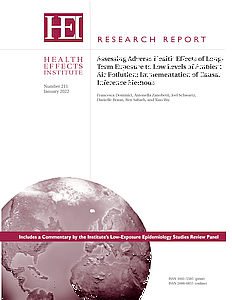You are here
New low-level air pollution exposure report examines risk of mortality in older Americans

A major new HEI report presents a study examining the risk of mortality associated with exposure to low ambient air pollution concentrations in a cohort of 68.5 million older Americans.
In the study, the team, led by Francesca Dominici, Harvard University, developed annual exposure models at a spatial resolution of 1 km × 1 km for the years 2000 to 2016 covering the contiguous United States for fine particulate matter (PM2.5), nitrogen dioxide (NO2), and ozone (O3).
Results from five different statistical approaches were consistent with each other and with results from previous low ambient air pollution studies, indicating an increased risks of all-cause mortality of 6% to 8% per 10 µg/m3 increase in PM2.5. Stronger associations were observed at the lowest levels of exposure, below the current annual national standard of 12 µg/m3.
In 2014, HEI issued RFA 14-3, Assessing Health Effects of Long-Term Exposure to Low Levels of Ambient Air Pollution, to improve our understanding of exposure–response functions for mortality and morbidity at low concentrations of PM2.5, NO2, O3, and other ambient air pollutants. Three studies, based in the United States, Canada, and Europe, were funded that incorporated state-of-the-art exposure methods and large cohorts in high-income countries. This U.S. report follows the release of the European study released in September 2021. The final Canadian report is expected later in 2022.
Read the report press release and statement below. Click here to download the full report and appendices.
| Attachment | Size |
|---|---|
| 233.34 KB | |
| 303.35 KB |

